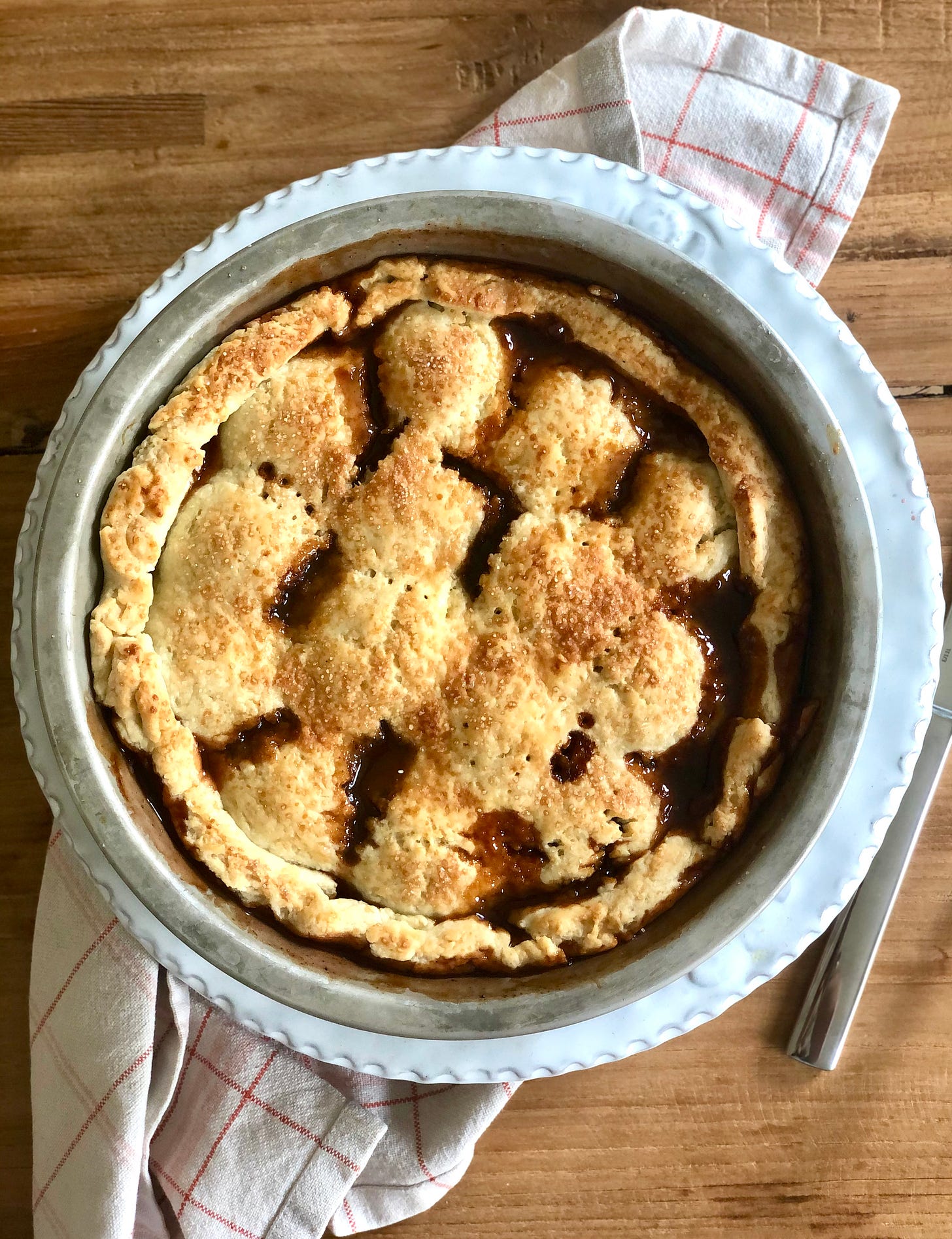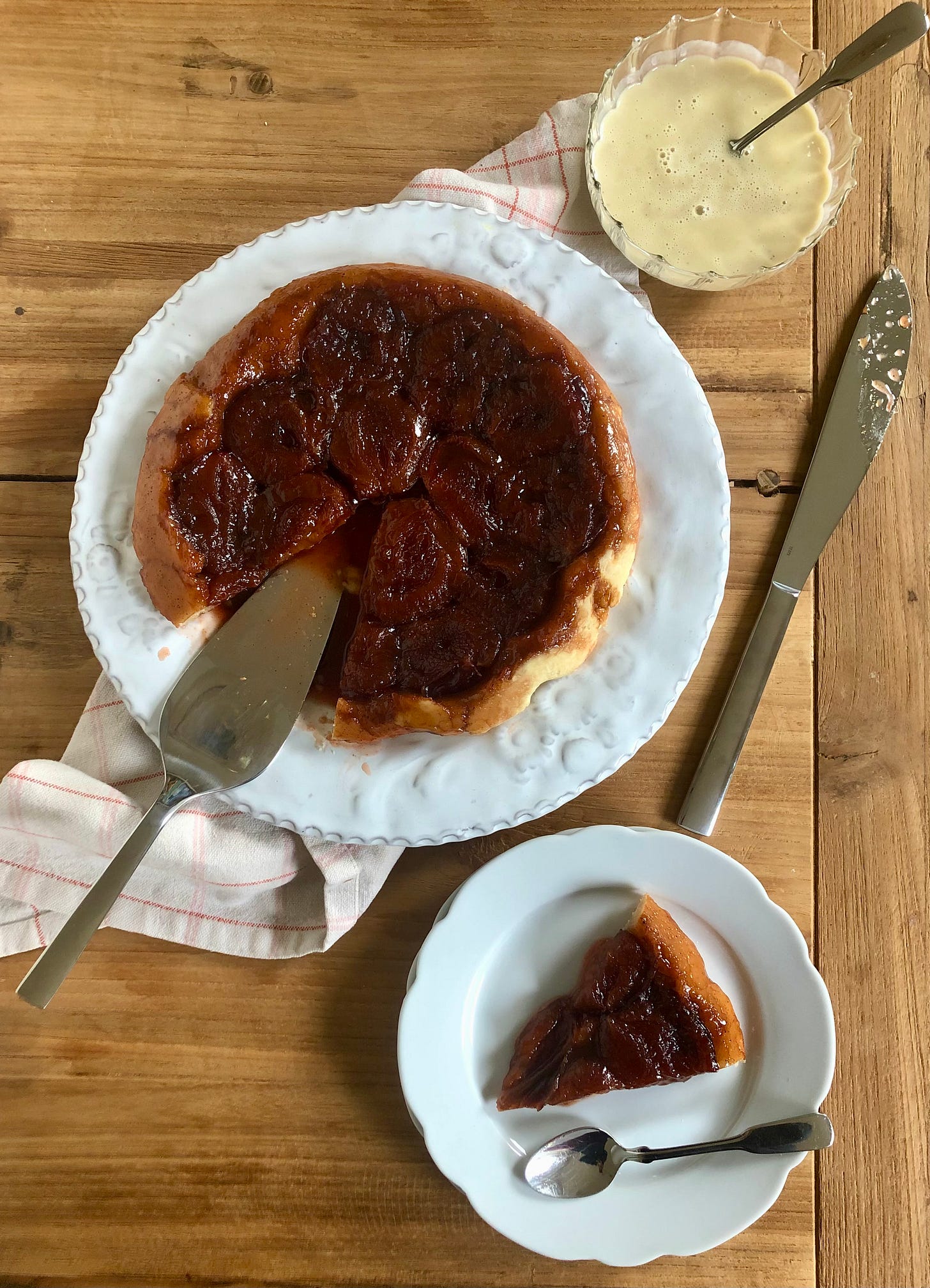Hello, and welcome to Newsletter No 39 here on Substack! Thank you for stopping by. If you are already subscribed - THANK YOU! Seeing thousands of you read my newsletters each month means the world to me! And if you are not yet a subscriber, hit the link below if you are interested in recipes as well as tips and tricks to make the most of our increasingly eclectic pantries and a good dose of my at times random musings about all things food!
❤️ Also, did you know that if you hit the HEART at the top or bottom of this post, it makes it easier for people to find this newsletter? (And also puts huge smile on my face!)
I once asked my followers on Instagram whether they were Team Shortcrust or Team Puff Pastry when it comes to Tarte Tatin. The unanimous answer was Team Shortcrust. Now, both shortcrust and puff pastry are perfectly acceptable when it comes to making Tarte Tatin. In fact, using (all butter!) shop bought Puff Pastry to quickly prepare an impressive dessert like Tarte Tatin for some last minute dinner guests is certainly not to be frowned upon. But in my (subjective) opinion, Tarte Tatin made with shortcrust pastry is superior in many ways. Texture-wise it is much nicer to have a bit of crunch from the crispy shortcrust base against the soft caramelized fruit sitting on top. Also, shortcrust pastry will not go soggy and hence chewy as quickly as a puff pastry base. And yes, shortcrust pastry can be tricky to master at first, but I will share two great little tricks I picked up during a pastry course at Le Cordon Bleu Cookery School in London:
The first trick is to use a technique called ‘fraisage’. What this means is that before bringing the dough together and shaping it into a disk to rest in the fridge, you smear the dough over your countertop little by little, using the heel of your hand. This helps blend the dough and creates long and alternating layers of butter and dough which results in a nice and crisp pastry.
A second trick which makes it much easier to roll out the dough after it has rested in the fridge is to divide the dough into 3-4 pieces and knead each piece until pliable. You then bring the separate pieces back together and form the dough into a disk before rolling it out.
But back to this Prune Plum Tarte Tatin. It’s one of these recipes for which the idea had been sitting in my notes folder on my iphone for far too long. Probably ever since I first made these Hot Cross Buns and which reminded me just how excellent Chinese Five Spice Powder works in sweet applications (this Prune Sticky Toffee Pudding with Chinese Five Spice Powder and a Miso Butterscotch Sauce is another great example for this).
While Chinese Five Spice Powder is more typically used in savoury cooking, there is no reason to stop there. This spice blend typically includes star anise, fennel, cassia, clove as well as Sichuan peppercorns for a bit of heat. So the overall flavour profile is not far off from mixed spice or gingerbread spice mixes. And I am all for making the most of the contents of your spice shelf! To finish this Tarte Tatin, there is a Tonka Bean Crème Anglaise, inspired by an incredibly delicious Tonka Bean Ice Cream my dad once made and which works great with the Prune Plums, which are a bit more acidic than other kinds of plum.
What are your favourite plums to bake with or create desserts with? And what is your favourite plum dessert or cake?
Reader survey
But before we get to this week’s recipe I have a small favour to ask. If you follow me on Notes or on Instagram, you might have already seen that I have prepared a short survey (no more than a handful of question) to help me plan the content for this Newsletter over the coming months.
In short, I am interested in knowing what ingredients (spices, condiments etc.) you have that are crowding your cupboards, lurking at the back of the fridge, have been opened once only to never be touched again etc. and that you would love to know what to do with. Click here to access the survey - I promise it will take less than 5 minutes to complete the survey!
Plum Tarte Tatin with Chinese Five Spice Powder and Tonka Bean Crème Anglaise
Note: You can easily make this Tarte Tatin with other kinds of plums or stone fruits, I just happen to be partial to prune plums. I find their flavour more complex since they have a bit more acidity than other plum varieties. They also have a slighter thicker skin which makes for an interesting texture. Flavourwise, if you don’t have any Chinese Five Spice Powder to hand you could either leave this out or use other warming spice mixes (e.g. Mixed Spice or Quatre Epices) or any of the following (individually or combined): ground cinnamon, cardamom, ginger, cloves, star anise etc. Same goes for the Crème Anglaise – vanilla is an obvious substitute for the tonka bean, but you could also try making the custard with cardamom for example. And yes, you can of course use puff pastry to make Tarte Tatin but I grew up eating shortcrust pastry with Tarte Tatin and prefer the texture.
Ingredients
For the Shortcrust Pastry
250g flour
Generous pinch of sea salt
125g cold butter, cubed
3-4 tbsp ice water
Milk to brush on the pastry before baking
Sugar to scatter over the pastry before baking
For the Plums
100g sugar
50g butter
1 tsp Chinese Five Spice Powder
7-10 prune plums (or enough to fill the bottom of a pie dish when cut in half)
For the Crème Anglaise
400ml milk
½ tonka bean, grated
30g sugar
4 egg yolks
2 tsp cornflour
Directions
Start by making the shortcrust pastry (note this can be done the day before you want to bake the Tarte Tatin). Add the flour to a large bowl and stir through the salt. Add the cubed butter and dust with flour. Using a pastry cutter or a knife, cut the butter into the flour until the mixture starts resembling wet sand and the butter pieces are no bigger than pea sized.
Using your index fingers and thumbs flatten the bigger lumps of butter into thinner strands. Next, and one tablespoon at a time, slowly start adding ice water to the dough, just enough until the dough starts coming together. You can test this by squeezing bits of the mixture in your fist and checking whether the mixture holds together. It’s fine if there are still some smaller dry bits, but the dough should start holding together in bigger clumps before you proceed to the next step. If it’s not there yet, add a little bit more ice water but try not to go overboard, 3-4 tbsp should do the trick.
Now, tip the shaggy mass of dough onto your countertop (no need to flour it first) and proceed to what the French call ‘fraisage’: using the heel of your hands, smear the dough across the countertop little by little before bringing it all back together, shaping it into a disk, wrapping it in clingfilm and placing it in the fridge for at least 1h.
Preheat the oven to 200 degrees Celsius.
In a small saucepan melt the sugar on medium heat. Once all the sugar has melted and turned amber in colour, add the butter. Be careful as the mixture may spit and bubble up quite violently but that will only take a few seconds. The mixture may also seize for a moment but simply place it back on medium heat and cook until you have a homogenous mix. Stir in the Chinese Five Spice Powder. Pour the caramel into the bottom of a pie dish. Next, cut your plums in half and remove the stone. Place the plums cut side down in your pie dish.
Lightly flour your countertop. Remove the shortcrust pastry from the fridge and set aside for 5 minutes to start coming to room temperature. Unwrap the dough, break into 3-4 pieces and knead each piece until pliable. Bring back together into a disk, then slowly roll out the dough into a circle a few cms bigger than the rim of your pie dish and 2-3mm in thickness.
Carefully transfer the shortcrust pastry to your pie dish and place on top of the plums (be careful here since the pie dish may be quite hot from the hot caramel). Gently press the shortcrust pastry dough against the plums, tucking the pastry in all around the outer edge of the plums and the walls of the pie dish. Cut off any excess dough and set aside.
Dock the pastry with a fork. Brush the top of the dough with milk and scatter over the sugar. Bake for 30-35 mins until the pastry is crisp and goldenbrown in colour. Set aside to cool for 5 minutes before carefully inverting onto a serving platter. Be careful with the hot caramel here (I like to use oven gloves and wear something long sleeved for this job).
While the Tarte Tatin is in the oven, make the Crème Anglaise. In a medium sized saucepan, heat the milk together with the grated tonka bean until the milk starts to steam. Meanwhile, whisk the eggs, sugar and cornstarch in a separate bowl. Pour ⅓ of the steaming milk over the egg yolks while whisking to temper the yolks. Pour this mixture back into the saucepan and, whisking continuously, continue cooking the Crème Anglaise until low to medium heat until it coats the back of a spoon. The grated tonka bean can feel the tiniest bit gritty so if that bothers you, simply strain the Crème Anglaise through a fine mesh sieve before serving.









I assume the 5 spice goes into the melted sugar after the butter is added?
This looks heavenly! Can't wait to try it.